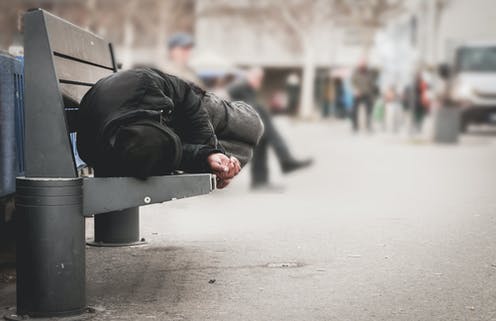Srdjan Randjelovic / Shutterstock
One surprising success story to come out of the pandemic was how many countries and cities were able to significantly reduce street homelessness. Lockdowns enabled governments to treat homelessness as a public health emergency and act swiftly to accommodate and support people experiencing homelessness.
There were two key fears when it came to homeless populations and the pandemic. First, that those who couldn’t stay at home risked spreading the virus. Second, that those experiencing homelessness would be stigmatised as vectors of the disease, while also being cut off from access to food, support and shelter. Providing emergency accommodation, much of it in private rooms, and taking steps to prevent new homelessness helped alleviate these fears.
Our new report from the Centre for Homelessness Impact and IPPO Cities, part of the International Public Policy Observatory (of which The Conversation is a partner), details the lessons we can learn from COVID about how to end homelessness in the long term.
1. Ending homelessness is a realistic policy goal
The combination of the right political will and funding shows us that street homelessness can be all but eliminated very quickly. This happened for a period in the UK, where 40,000 people moved out of emergency accommodation into longer term accommodation between March 2020 and November 2021.
The public health necessity of housing those experiencing homelessness created a political imperative for radical action. Many governments provided dedicated funding in the initial phase of the pandemic, vastly increasing the resources available to tackle the problem.
While not all gains were permanent, the fact that this took place at all shows that the goal of ending homelessness permanently is realistic.
2. Suspending eligibility criteria helps
Reducing homelessness also means removing the barriers for people to get help. Governments often distribute resources like housing support based on set criteria, like whether you are supporting a family. But the pandemic shows us that a more universal approach – offering housing to everyone regardless of their specific circumstance – works much better.
Prior to COVID, the UK excluded certain people from accessing publicly funded accommodation based on immigration status or for other reasons of having “no recourse to public funds”. This meant some homeless people, many of them sleeping rough or in shelters, had little prospect of resolution. Removing this restriction on eligibility allowed those previously existing under the radar of local authorities to access services and be housed and counted for the first time.
3. Collaboration is key
Ending homelessness can’t be done by the government alone – it requires collaboration with the voluntary and private sectors who have the specialist expertise, on the ground know-how and resources necessary for effective action.
The widespread shuttering of the leisure travel industry led to an available stock of private sector hotel rooms which were then used to house people. This public-private cooperation allowed individuals to be housed in their own rooms, which was also important for preventing transmission of COVID.

John B Hewitt / Shutterstock
There was also coordination between different services not previously as directly involved in housing and homelessness. In London, health workers provided initial health screenings, while mental health professionals gave support to homeless people in accommodation.
Making this kind of collaboration permanent, as well as shifting away from the use of shelters and communal hostels and towards single rooms, is necessary for a permanent end to homelessness. The provision of own-room accommodation during the pandemic increased people’s sense of dignity and self-worth in addition to preventing COVID transmission.
4. Eviction bans work
Many countries also took action to help those at risk of becoming homeless by introducing eviction bans, which protect tenants from being forced from their homes.
In Houston in the US, a programme to support people at the point of eviction directed 2,895 individuals away from risk of homelessness into alternative housing. A separate rent relief programme supported tens of thousands more tenants at risk of becoming homeless. Together, these measures also allowed existing resources to be targeted at those who were currently without a home.
While making a comprehensive eviction ban permanent is perhaps not possible, the pandemic shows it is a helpful tool in preventing new homelessness.
5. A clear mandate is needed
COVID showed us that ending street homelessness is possible with the right political will and corresponding funding. Designating it as a public health crisis provided a necessary and clear mandate that unlocked the tools to take decisive action.
However, many of the gains made during lockdowns have not endured. Homelessness in England in the period July-September 2021 had returned broadly to pre-pandemic levels.
For the kind of concerted action which worked during the pandemic to become more permanent, many countries will require a change in approach, including an expanded role for the state.
The Centre for Homelessness Impact and the IPPO Cities are hosting an online roundtable event to discuss the lessons of the pandemic for ending homelessness on Thursday 31 March 2022, from 3:30 pm to 5:00 pm. Sign up here.
![]()
Jeremy Williams works for the International Public Policy Observatory, of which The Conversation is a partner organisation.











